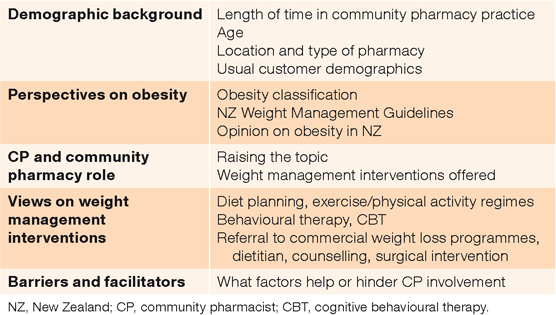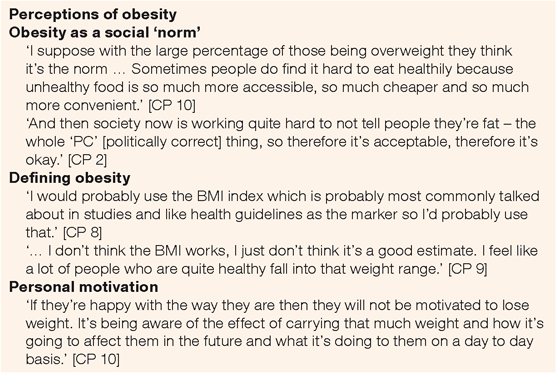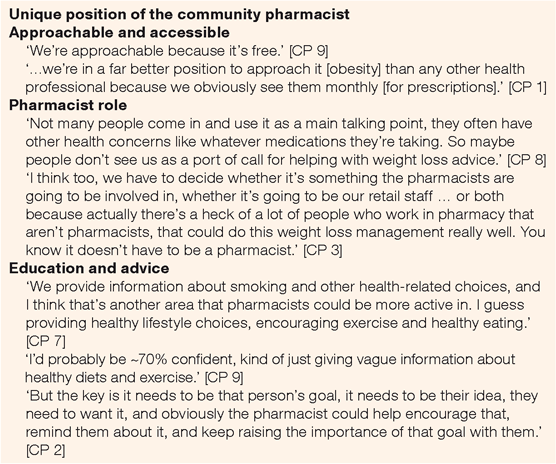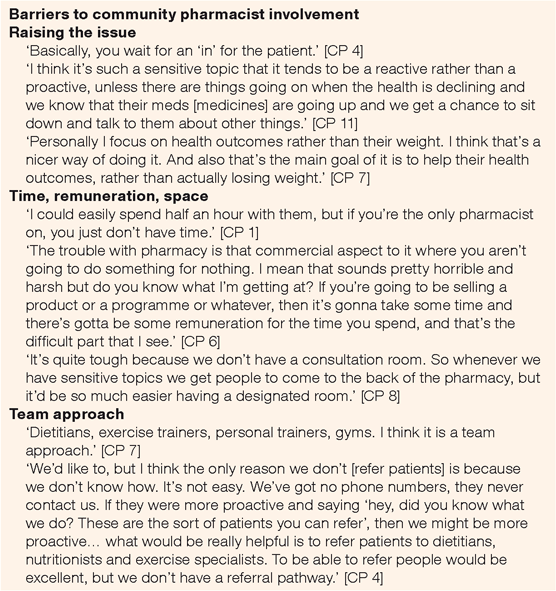“Basically you wait for an ‘in’’’: community pharmacist views on their role in weight management in New Zealand
Lesley Gray 1 , Rachel Chamberlain 2 , Caroline Morris 11 Department of Primary Health Care & General Practice, University of Otago, Wellington, New Zealand
2 Bachelor of Dental Surgery Student, University of Otago, Dunedin, New Zealand
Correspondence to: Lesley Gray, Department of Primary Health Care & General Practice, Te Tari Hauora Matamua me te Matauranga Rata Whanau, School of Medicine and Health Sciences, University of Otago, Wellington, PO Box 7343, Wellington, New Zealand. Email: lesley.gray@otago.ac.nz
Journal of Primary Health Care 8(4) 365-371 https://doi.org/10.1071/HC16026
Published: 21 December 2016
Journal Compilation © Royal New Zealand College of General Practitioners 2016.
This is an open access article licensed under a Creative Commons Attribution-NonCommercial-NoDerivatives 4.0 International License.
Abstract
INTRODUCTION: Obesity is now widely regarded as the main contributor to poor health globally, overtaking tobacco as the leading potentially modifiable risk to health. Community pharmacists are delivering an increasing number of extended services and are potentially well placed to contribute to obesity management strategies. No studies to date have investigated the views of community pharmacists in New Zealand about their role in weight management.
AIM: To explore the views of community pharmacists in one region of New Zealand about their role in weight management, including the perceived barriers and facilitators to their involvement.
METHODS: Qualitative, face-to-face, semi-structured interviews were undertaken with 11 community pharmacists from the Greater Wellington region. Interviews were transcribed verbatim and analysed thematically using an inductive approach.
RESULTS: Four key themes were identified from data analysis. These were: (i) perceptions of obesity; (ii) perceptions of weight management treatment options; (iii) the unique position of the community pharmacist; and (iv) barriers to involvement. The main barriers described included: (i) a lack of time and remuneration; (ii) the absence of an appropriate space within the pharmacy to discuss weight-related matters; (iii) and a lack of awareness of who to contact for specialist support.
DISCUSSION: Community pharmacists in Greater Wellington believe that they have a distinct role in their local community and can contribute to a multidisciplinary approach to reduce levels of obesity. Further work is required to determine the most appropriate role for community pharmacy in weight management and the training needs for pharmacy staff to optimally fulfil this role.
KEYWORDS: Community pharmacy; obesity; pharmacist; primary health care; weight management; multidisciplinary
| WHAT GAP THIS FILLS |
| What is already known: Obesity is a significant public health challenge in New Zealand. International research has investigated the potential role of community pharmacy in weight management strategies and the main barriers to involvement. |
| What this study adds: Despite differences in the delivery and funding of primary health care services, community pharmacists from a single region of New Zealand perceive similar barriers to their international counterparts to the delivery of weight management services. The study findings highlight the need to define a relevant and useful role for community pharmacy nationally and to identify clear training needs for all members of pharmacy staff in the area of weight management in New Zealand. |
Introduction
Obesity is widely regarded as the main contributor to poor health globally.1 Based on New Zealand (NZ) risk factor exposure data, it is overtaking tobacco as the leading potentially modifiable risk to health.2 Recent data identified that 46% and 67% of Māori and Pacific island adults, respectively, are obese,3 and that NZ has the third highest adult obesity rate in the Organisation for Economic Co-operation and Development (OECD), with rates rising.4 It has been acknowledged that tackling obesity will require multi-level action and accountability,5 with warnings given that health professionals are currently poorly prepared to tackle this issue.6
Internationally, community pharmacists (CPs) are delivering an increasing number of extended services, including more preventative services (eg smoking cessation programmes, sexual health services, influenza vaccination, weight management).7–11 Although opportunities exist for more public health initiatives to be delivered through community pharmacies,12,13 pharmacists’ confidence in their ability to deliver such services has been identified as ‘average to low’.13
Previous empirical research has been conducted in Europe, North America and Australia on the role of the CP in weight management.14–20 This identified a range of barriers to involvement, including increased workload and lack of remuneration,16 and a lack of patient awareness of the potential role for pharmacists in this area.17 While national studies indicate that some CPs are providing, or would like to provide, services related to weight management,7,8 there has been no work to date that specifically investigates CPs’ views of their role. The aim of this study was therefore to explore CPs’ opinions of their role in weight management, including the perceived barriers and facilitators to their involvement.
Methods
Semi-structured, face-to-face interviews were used to explore the views of a sample of CPs in the Greater Wellington Region about their role in weight management. Participants were purposively sampled to ensure that a diverse range of CPs was included, and that variation existed in both the type and location of pharmacies in which they worked.
Eleven CPs from ten community pharmacies were interviewed. Three responded to an invitation to participate, which was placed in a local newsletter for pharmacists, five were recruited through existing connections with local CPs, and three by snowball sampling of early participants.
The final sample included seven women and four men, ranging in age from 23 years to over 60 years. Their length of time in professional practice ranged from 18 months to over 30 years. Five participants worked in pharmacies that were independently owned and six in pharmacies that were part of a national franchise. The pharmacies were located in both urban and rural areas and served communities with a range of patient demographics, including low and high income and areas with high proportions of Māori and Pacific Island patients.
Interviews were conducted by RC using an interview schedule (Table 1) covering five broad topic areas:
-
Demographic background
-
Perspectives on obesity
-
The role of the CP and community pharmacy
-
Views on weight management interventions
-
Barriers and facilitators to involvement

|
Interviews averaging 28 min in length (range: 22–38 min) were audio-recorded with consent and transcribed verbatim. Participants were sent a copy of the transcript and offered the opportunity to review the content and amend any discrepancies before data analysis. Preliminary thematic analysis was undertaken by RC using an inductive approach;21 organising the quotes, by theme, into ‘Word’ documents. LG and CM also independently reviewed all the transcripts. The initial themes were discussed and refined as necessary, with all authors reviewing and agreeing on the final themes.
This study was approved by the University of Otago Human Ethics Committee (Reference Number D14/387). Research consultation with Māori took place using standard University of Otago processes.
Results
Thematic analysis
Four key themes were identified from analysis of the data. These included: (i) CP perceptions of obesity; (ii) CP opinion on weight management treatment; (iii) the unique position of the CP; and (iv) barriers to CP involvement. These are described in more detail below, together with illustrative quotations.
Theme 1: perceptions of obesity
A common perception was that obesity has become a social ‘norm’, attributable, in part, to the accessibility and relative low cost of unhealthy food. In terms of defining obesity, mixed views were expressed on whether body mass index (BMI) was an accurate or acceptable measure, with some believing that many people who were not obese had a high BMI. Participants considered patient acknowledgment of their weight and its potential impact on their health as key for interventions to be successful. Both personal motivation and personal responsibility to lose weight and readiness to change were seen as paramount.
Table 2 provides a selection of participant quotations on these topics.

|
Theme 2: weight management treatment options
Two participants were aware of the New Zealand Weight Management Guidelines,22 although neither had read them. Overall, participants viewed changes to diet as an effective weight management intervention, often describing this alongside exercise. These lifestyle changes were perceived as key as they were considered most easily achievable by people. Management of weight loss with medicines was generally considered a thing of the past due to their side-effect profile, but had in some cases been successful. Three participants were employed in a pharmacy that sold commercial weight loss products. However, only one participant perceived them in a favourable light, another considering them a short-term ‘fix’.
The use of cognitive behavioural therapy (CBT) was considered a potential weight loss tool by eight participants. Of these, two participants felt CBT might have a role where other strategies had already failed, and one felt CBT should be attempted before moving to surgical options. One participant considered that some overweight patients may not be receptive to the idea that there was a behavioural element to weight loss.
Despite some concerns about bariatric surgery, including the risks involved during surgery, side-effects and the struggle that comes with a restrained diet post-surgery, several participants perceived it to have a valuable place for appropriate candidates. This included younger people where the potential for long-term benefit was greater. There was a general consensus that the opportunity for community pharmacy involvement in specialised weight management interventions, for example, supporting patients post bariatric surgery, was limited due to the pharmacists’ focus on medicines.
Table 3 provides a selection of participant quotations on these topics.

|
Theme 3: unique position of the CP
All participants believed that they held a distinct position compared to other community-based healthcare providers. They perceived themselves as approachable, saw some patients on a regular basis due to prescription dispensing, and considered that their services were potentially more ‘accessible’ given that their advice is provided free of charge. A minority of interviewees thought that patients only consider CPs to have a role to play in relation to medicines and hence not for issues like weight management. Two interviewees highlighted that there was potentially a role for staff who were not trained as pharmacists (eg pharmacy counter staff).
All participants viewed the provision of education and advice about a healthy lifestyle (including diet and exercise) as a key part of their role in weight management. While the majority were confident in their ability to give this type of advice, a few (particularly the more recently qualified CPs) felt less confident.
Participants also saw themselves providing a supportive role for patients by virtue of their ability to monitor patients frequently. This included helping patients to self-manage. Success was perceived in this context as the patient meeting their own individual goals.
Table 4 provides a selection of participant quotations on these topics.

|
Theme 4: barriers to CP involvement
Some participants expressed difficulty in addressing the potentially sensitive issue of weight with patients for fear of causing offence. They would therefore normally wait for the patient to introduce the topic first, or introduce the topic themselves in the context of other health conditions. A few participants would focus on health markers (eg blood pressure and cholesterol) rather than weight, per se, as a way of overcoming the challenge of the sensitivity of the issue.
Participants also identified several practical constraints that potentially hindered their ability to help patients with weight management. These included a lack of time, particularly when the pharmacy operated with a single pharmacist, and lack of remuneration for the time taken to provide these services. The absence of an appropriate location, such as a private consultation room, for a discussion to take place around this sensitive topic area was also identified.
The majority of participants identified a need for a multidisciplinary approach to weight management. This included the patients’ general practitioner alongside individuals with other areas of expertise; for example, dietitians, nutritionists, personal trainers. Many expressed a willingness to refer patients to other professionals and services if there was a defined pathway in place. However, a significant barrier to a team approach expressed by participants was a lack of awareness of appropriate named contacts at present. Some CPs noted that it would be helpful if other service providers made direct contact so that the community pharmacy was aware of specific expertise available in the local area.
Table 5 provides illustrative quotes from interviews on these topics.

|
Discussion
This is the first study to explore CPs’ views on obesity and their potential role in weight management in NZ.
The findings suggest that CPs feel that they or their staff are well placed to provide weight management advice and services, because they believe they are accessible and approachable. Furthermore, their frequent contact with some patient groups who collect regular prescription medicines could further facilitate an active role in the delivery of weight management strategies. These findings align with previous international research findings,13,23 with CPs perceived as well placed to deliver planned public health initiatives.
Paradoxically, the key features of community pharmacy that facilitate a role (accessibility, approachability, available without an appointment and free from charge) were also the underlying source of some of the barriers cited, including lack of time and remuneration. These are issues that are often raised in relation to an extension of the CP’s role.13 Sensitivity about raising obesity was also a recurring feature; an issue also identified by other health professional groups in the Greater Wellington region.24 For CPs, this was often linked to the need for an appropriate ‘private’ space away from the public area to have the discussion. Participants also believed that there was a lack of awareness by patients of their knowledge and skills in this area, aligning with previous international findings.25,26
There is potential for community pharmacy to have two discreet areas of focus: (i) regular ‘patients’ with multi-morbidity could be pro-actively targeted as they present to formal long-term condition services;27 and (ii) providing reactive advice to ‘customers’ finding it more convenient or acceptable to visit the pharmacy rather than making an appointment with their doctor, or paying to see their doctor for advice.
Time pressures for CPs may be different to those of pharmacy support staff, and a possible solution to time and remuneration issues may lie in expanding the role of these staff. There is national evidence to suggest that support staff consider a weight management service as appropriate for specific patient groups.8
Training, education and clear roles that are appropriate for the level of training of the different members of pharmacy staff will undoubtedly be key. While this study did not set out to measure CPs’ knowledge about weight management interventions, it is notable that most of the interviewees were unaware of the New Zealand Weight Management Guidelines.22 Similarly, very few pharmacies across Australia indicated that they relied on weight management guidelines.15 Internationally, studies of CPs and pharmacy support staff have identified a need for educational resources specific to pharmacy, extra training for both CPs and pharmacy assistants to help optimise the delivery of weight management services,15 and the development of a practice-based model for community pharmacy that delineates clear roles for all staff members.28
Recognition of the need for a multidisciplinary approach by participants is promising, and the recently published Ministry of Health Pharmacy Action Plan29 acknowledges the benefits of an integrated operating model and the need to strengthen an interprofessional approach in general. A previous study identified minimal integration with other healthcare providers in the area of weight management.28 Opportunities exist to develop multidisciplinary training and education in the primary healthcare setting to support the implementation of evidence-based weight management strategies and clear collaborative pathways in NZ. In recent years, obesity prevention efforts are moving towards the ‘whole systems approach’. This requires engagement across a wide range of policy influencers and shapers at local, regional and national levels, with health being one small part of this approach.30 However, clarity about the role, scope and pathway for all involved disciplines is needed.
Strengths and limitations
For pragmatic reasons relating to time and resource constraints, this study was conducted in a single region of New Zealand involving 11 pharmacists from Greater Wellington. It is possible that a purposive sample of CPs in another region might have expressed different views. Despite this, the final sample included a diverse range of participants who were practising in a variety of different locations serving demographically diverse populations. There was a structured and transparent approach to data collection and analysis, with all participants offered the opportunity to review their interview transcripts. A single student researcher undertook the interviewing, transcribing and preliminary analysis; the two other authors, from a public health and pharmacy background, independently reviewed the transcripts, themes and coding. This study focused solely on CPs and did not seek the views of pharmacy support staff that may also have a valuable role to play in the delivery of weight management services.
Conclusion
CPs from the Greater Wellington area of New Zealand believe that they have a niche position in their local community and can contribute to a multidisciplinary approach to help reduce levels of obesity. To date, the contribution of CPs nationally remains largely untapped. Further research is needed to determine the most appropriate roles and specific training needs for the different types of staff employed in community pharmacies, and the level of patient support or intervention best suited to the pharmacy environment.
COMPETING INTERESTS
None declared.
Acknowledgements
The authors would like to thank the Wellington Faculty of the Royal New Zealand College of General Practitioners for funding this project, the CP participants and the Editor of the Pharmacy Informer newsletter for publicising our invitation to participate.
References
[1] Ng M, Fleming T, Robinson M, et al. Global, regional, and national prevalence of overweight and obesity in children and adults during 1980–2013: a systematic analysis for the Global Burden of Disease Study 2013. Lancet. 2014; 384 766–81.| Global, regional, and national prevalence of overweight and obesity in children and adults during 1980–2013: a systematic analysis for the Global Burden of Disease Study 2013.Crossref | GoogleScholarGoogle Scholar |
[2] Ministry of Health. Health loss in New Zealand: a report from the New Zealand Burden of Diseases, Injuries and Risk Factors Study, 2006–2016. Wellington: Ministry of Health; 2013.
[3] Ministry of Health. The annual update of key results 2013/14: New Zealand Health Survey. 2014. [cited 2016 June 20]. Available from: http://www.health.govt.nz/publication/annual-update-key-results-2013-14-new-zealand-health-survey
[4] Ministry of Health. Obesity. Wellington: Ministry of Health; 2015. [cited 2016 June 20]. Available from: http://www.health.govt.nz/our-work/diseases-and-conditions/obesity
[5] Swinburn B, Kraak V, Rutter H, et al. Strengthening of accountability systems to create healthy food environments and reduce global obesity. Lancet. 2015; 385 2534–45.
| Strengthening of accountability systems to create healthy food environments and reduce global obesity.Crossref | GoogleScholarGoogle Scholar |
[6] Dietz WH, Baur LA, Hall K, et al. Management of obesity: improvement of health-care training and systems for prevention and care. Lancet 2015; 385 2521–33.
| Management of obesity: improvement of health-care training and systems for prevention and care.Crossref | GoogleScholarGoogle Scholar |
[7] Zolezzi M, Bye L, Harrison J, et al. Provision of health/disease screening and medication monitoring/management in New Zealand community pharmacies. J Pharm Pract Res. 2014; 44 188–94.
| Provision of health/disease screening and medication monitoring/management in New Zealand community pharmacies.Crossref | GoogleScholarGoogle Scholar |
[8] Horsfield E, Kelly F, Sheridan J, et al. Could community pharmacies help to improve youth health? Service availability and views of pharmacy personnel in New Zealand. Int J Public Health 2014; 59 789–98.
| Could community pharmacies help to improve youth health? Service availability and views of pharmacy personnel in New Zealand.Crossref | GoogleScholarGoogle Scholar |
[9] Pharmaceutical Society of New Zealand. New Zealand National Pharmacist Services Framework. Wellington: Pharmaceutical Society of New Zealand Inc.; 2014.
[10] Scottish Executive. New community pharmacy contract update, HDL, 36. Edinburgh; 2004. [cited 2016 June 20]. Available from: www.sehd.scot.nhs.uk/mels/HDL2004_36.pdf
[11] Pharmaceutical Services Negotiating Committee. NHS Community Pharmacy services – a summary. 2015. [cited 2016 June 20]. Available from: http://psnc.org.uk/wp-content/uploads/2015/06/CPCF-summary-June-2015.pdf
[12] Boardman H, Lewis M, Croft P, et al. Use of community pharmacies: a population-based survey. J Public Health. 2005; 27 254–62.
| Use of community pharmacies: a population-based survey.Crossref | GoogleScholarGoogle Scholar |
[13] Eades CE, Ferguson JS, O’Carroll RE. Public health in community pharmacy: a systematic review of pharmacist and consumer views. BMC Public Health. 2011; 11 582
| Public health in community pharmacy: a systematic review of pharmacist and consumer views.Crossref | GoogleScholarGoogle Scholar |
[14] Um IS, Armour C, Krass I, et al. Weight management in community pharmacy: what do the experts think? Int J Clin Pharm. 2013; 35 447–54.
| Weight management in community pharmacy: what do the experts think?Crossref | GoogleScholarGoogle Scholar |
[15] Fakih S, Marriott JL, Hussainy SY. A national mailed survey exploring weight management services across Australian community pharmacies. Aust J Prim Health. 2015; 21 197–204.
| A national mailed survey exploring weight management services across Australian community pharmacies.Crossref | GoogleScholarGoogle Scholar |
[16] Newlands RS, Watson MC, Lee AJ. The provision of current and future Healthy Weight Management (HWM) services from community pharmacies: a survey of community pharmacists’ attitudes, practice and future possibilities. Int J Pharm Pract. 2011; 19 106–14.
| The provision of current and future Healthy Weight Management (HWM) services from community pharmacies: a survey of community pharmacists’ attitudes, practice and future possibilities.Crossref | GoogleScholarGoogle Scholar |
[17] George K, Lovelady C, Connolly D, et al. Community pharmacy contribution to weight management: identifying opportunities. Int J Pharm Pract. 2010; 18 7–12.
| Community pharmacy contribution to weight management: identifying opportunities.Crossref | GoogleScholarGoogle Scholar |
[18] Blenkinsopp A, Anderson C, Armstrong M. Community pharmacy’s contribution to improving the public’s health: the case of weight management. Int J Pharm Pract. 2008; 16 123–5.
| Community pharmacy’s contribution to improving the public’s health: the case of weight management.Crossref | GoogleScholarGoogle Scholar |
[19] O’Neal KS, Crosby KM. What is the role of the pharmacist in obesity management? Curr Obes Rep. 2014; 3 298–306.
| What is the role of the pharmacist in obesity management?Crossref | GoogleScholarGoogle Scholar |
[20] Lloyd KB, Thrower MR, Walters NB, et al. Implementation of a weight management pharmaceutical care service. Ann Pharmacother. 2007; 41 185–92.
| Implementation of a weight management pharmaceutical care service.Crossref | GoogleScholarGoogle Scholar |
[21] Boyatzis R. Thematic analysis and code development: transforming qualitative information. London and New Delhi: Sage Publications; 1998.
[22] Ministry of Health, Clinical Trials Research Unit. Clinical guidelines for weight management in New Zealand adults. Wellington: Ministry of Health; 2009; [cited 2016 June 20]. Available from: www.health.govt.nz/publication/clinical-guidelines-weight-management-new-zealand-adults
[23] Um IS, Armour C, Krass I, et al. Managing obesity in pharmacy: the Australian experience. Pharm World Sci. 2010; 32 711–20.
| Managing obesity in pharmacy: the Australian experience.Crossref | GoogleScholarGoogle Scholar |
[24] Gray L, Dowell T, Macdonald L, et al. Getting TabOO issues on the table: talking about overweight and obesity in New Zealand General Practice. Obes Res Clin Pract. 2014; 8 41–2.
| Getting TabOO issues on the table: talking about overweight and obesity in New Zealand General Practice.Crossref | GoogleScholarGoogle Scholar |
[25] Um IS, Armour C, Krass I, et al. Consumer perspectives about weight management services in a community pharmacy setting in NSW, Australia. Health Expect. 2014; 17 579–92.
| Consumer perspectives about weight management services in a community pharmacy setting in NSW, Australia.Crossref | GoogleScholarGoogle Scholar |
[26] O’Donnell DC, Brown CM, Dastani HB. Barriers to counseling patients with obesity: a study of Texas community pharmacists. J Am Pharm Assoc. 2006; 46 465–71.
| Barriers to counseling patients with obesity: a study of Texas community pharmacists.Crossref | GoogleScholarGoogle Scholar |
[27] Central Region’s Technical Advisory Services Limited. Long term conditions service. [cited 2016 June 27]. Available from: http://centraltas.co.nz/community-pharmacy/long-term-conditions-service/long-term-conditions-service-2/
[28] Weidmann AE, MacLure K, Marshall S, et al. Promoting weight management services in community pharmacy: perspectives of the pharmacy team in Scotland. Int J Clin Pharm. 2015; 37 599–606.
| Promoting weight management services in community pharmacy: perspectives of the pharmacy team in Scotland.Crossref | GoogleScholarGoogle Scholar |
[29] Ministry of Health. Pharmacy Action Plan 2016 to 2020. Wellington: Ministry of Health; 2016. [cited 2016 June 20]. Available from: www.health.govt.nz/publication/pharmacy-action-plan-2016-2020
[30] Sacks G, Swinburn BA, Lawrence MA. A systematic policy approach to changing the food system and physical activity environments to prevent obesity. Aust New Zealand Health Policy. 2008; 5 13
| A systematic policy approach to changing the food system and physical activity environments to prevent obesity.Crossref | GoogleScholarGoogle Scholar |


